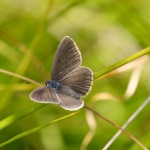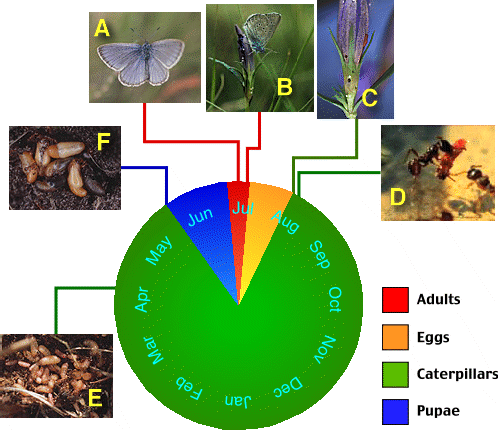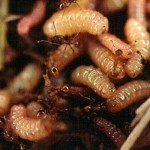
The beautiful and rare Alcon Blue butterfly, Maculina alcon, has a surprising life cycle; for about nine months of the year it behaves like a cuckoo. It belongs to a large family of butterflies, the Lycaenidae, many of whom have a special relationship with ants. Its lays its eggs on the flower buds of the Marsh Gentian and the flowers become the first food source for the caterpillars. They feed here until they have undergone three moults, when they drop to the ground. If they are found by a particular species of red ant, a Myrmica ant, the larva will produce a sweet substance that is eaten by the ant, which will then adopt it and carry it back to the ant’s nest. Once in the nest, the Alcon Blue becomes a parasite, much like cuckoo chicks do. The ants will feed the adopted larvae in preference to their own, and the ant colony will produce fewer offspring.
The caterpillars spend up to 23 months underground in the ant nest. During this period the Alcon Blue caterpillars increase their weight by up to 100 times before pupating. When the adult butterfly emerges from the pupa, it crawls out of the ants nest. At this stage the ants attack it, but it is protected by the scales covering its body.The life cycle has been illustrated by David Nash and colleagues of the Social Insects Group at the Universities of Copenhagen and Aarhus.

In order to avoid the aggressive behaviours usually displayed by ants towards intruders in their nests, Alcon Blue caterpillars have evolved a form of chemical mimicry whereby the surface molecules of the caterpillars closely match those of their ant host and the better their surface molecules match their hosts, the more successful they are. Marco Sala and colleagues from the University of Turin have just published a study demonstrating that this sophisticated relationship has even greater depth to it. Not only does the butterfly mimic the surface chemicals of its host but also the sounds it makes; known as acoustical mimicry.
Obtaining their material from the wild, the group set up colonies of the ant host, Myrmica scabrinodis, in the laboratory and reared two species of Alcon Blue caterpillars, Maculin alcon, the cuckoo species, and Maculina telius, a predatory species collected by the same red ants. This allowed a comparison between the cuckoo species that is fed and tended by the ants and the related species that preys upon the ant larvae. Sound recordings were made of worker and queen ants and the caterpillars, both before and after adoption by the ants. The researchers could distinguish between sounds made by worker and queen ants, the queens producing sounds of higher intensity and lower frequency than the workers. Sounds produced by the butterfly larvae pre- and post-adoption were observed to change, with the cuckoo species producing a higher intensity sound post-adoption and the predatory species a lower intensity sound. Interestingly, the sounds made by M. alcon were the same as those made by the queen ants and sounds made by the predator, M. telius were similar to the workers.

In addition, behavioural tests were performed by exposing worker ants to MP3 sound recordings of the worker and queen ants, the caterpillars, and to white noise as a control. The workers responded more to the various insect sounds than to white noise and the sounds most clearly eliciting a response were those produced by queens and by post-adoption cuckoo species rather than by worker ants. However, recordings made of the predator species at the pre-adoption phase produced slightly stronger responses than those from the cuckoo species at this stage in its life cycle.
One type of behaviour recorded was that of digging, a response associated with rescuing ant larvae trapped under soil, as might happen if a nest is disturbed. It had previously been noted that cuckoo larvae were rescued by worker ants in preference to their own larvae when nests were experimentally disturbed in a laboratory setting. Other behaviours recorded included walking and tapping the MP3 player with their antennae, both these behaviours are associated with food-exchange and nest-mate recognition.
The authors conclude that both the cuckoo and the predatory species of butterfly have cracked the ant’s communication code and produce sounds very similar to the stridulations that are that are made by the queen ant. In particular, the cuckoo species, by mimicking the queen, achieves a high social status in the colony and, presumably, they will be treated as queen ants. Interestingly, the predatory butterflies produced lower intensity sounds post-adoption, consistent with their lack of need to elicit tending behaviours in the workers as once they have been adopted they will prey on the ant larvae. In contrast, pre-adoption they emit higher frequency sounds to attract ants so that they will be carried back to the nest. Clearly acoustic signals are changing with the phase of the butterfly life cycle and the evidence reported in this paper supports the view that these signals are likely to enhance the chemical mimicry that enables the adoption of these parasites by the ant colony.

2 Comments